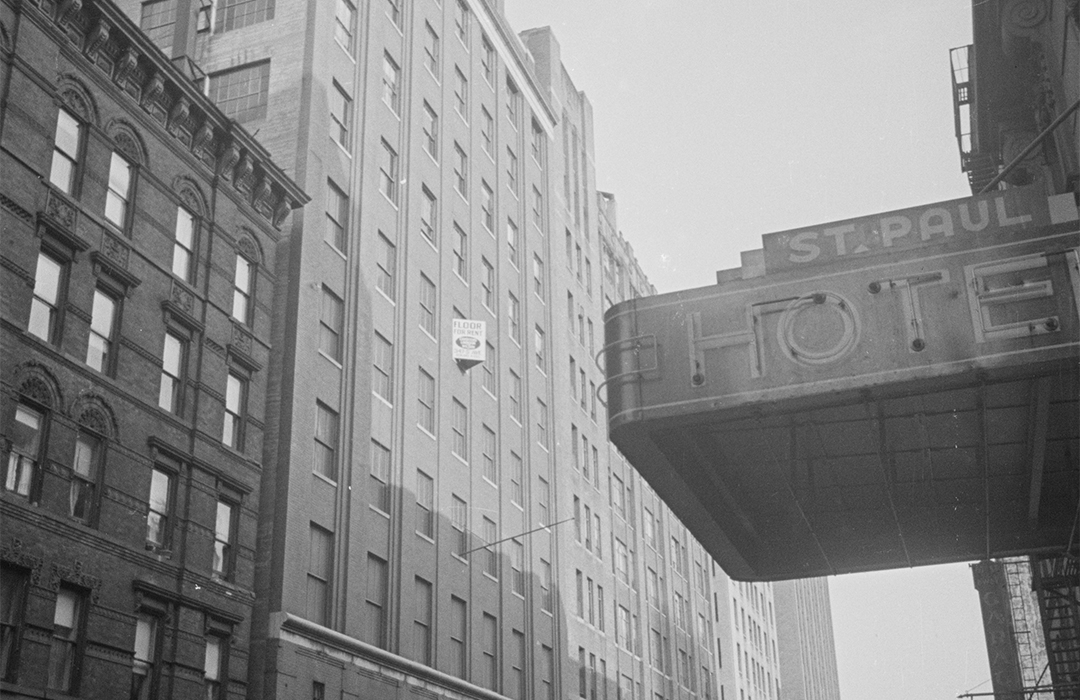
The Boyerton Casket Co. Building — 39-43 West 60th Street
by Tom Miller
Two undertakers in Boyertown, Pennsylvania named Wagner and Brumbach reportedly were forced to postpone funerals when they could not obtain caskets. To solve the problem, they founded the Boyertown Burial Casket Company. By the end of World War I, it was the second-largest casket manufacturer in the country. In 1917, the firm purchased six structures at the southwest corner of Eighth Avenue and 43rd Street for the site of its latest New York City showroom building. Within just ten years, that structure was inadequate.
John P. Spatz was a vice-president of the Boyertown Casket Company and the manager of the New York City operation. In 1927, he hired architect Van F. Pruitt to design an eleven-story office and loft structure at 39-43 West 60th Street, running through the block to 32-38 West 61st Street. Completed two years later, its Art Deco design included a two-story base with a double-height central section filled with stained glass—no doubt a condition of the ground floor tenant, the Eugene Brown & Son Funeral Chapel. The brick-faced upper section featured full-height molded piers.
Boyertown Casket Company was well known throughout the country. Earlier, magician Harry Houdini had a custom-made casket made for his escape act. In 1926, a year before ground was broken for the West 60th Street building, he was buried in that same casket. The caskets for the funerals Will Rogers, Liberace, Marilyn Monroe, President John F. Kennedy and Robert F. Kennedy would be constructed by the Boyertown Casket Company in the coming years.
Boyertown Casket Company was well known throughout the country.
The Boyertown Casket Building was designed with additional space for rental income. Ne-Agra Corp., a research and engineering development firm, was among the first tenants. The Alsop Engineering Co., a manufacturer of liquid filtration equipment, moved into the building on April 1, 1930. The Milk Dealer reported in its March issue that year, “This magnificent new building with every modern improvement and light on three sides will enable the company to function with the greatest efficiency and give service never before possible.”
As early as 1937, an interesting tenant here was the showroom and factory of the National Organ and Sound System Company. The firm rebuilt pipe organs and supplied organ parts such as pipes, chimes, harps, blowers, motors, and more.
By 1939, the funeral home was known as the Columbus Circle Chapel. It would remain such until around 1956 when Green & Vanderburgh, “embalmers and funeral directors,” took over the space. It was a short-lived enterprise, and in 1958 William H. Graham’s “The Funeral Home,” had moved in.
In the meantime, the upper floors continued to attract engineering and development firms. Among them was Lepel High Frequency Laboratory, Inc., headed by Egbert Von Lepel. The firm invented and manufactured electrical equipment. Lepel was a pioneer in the development of high-frequency apparatus. The New York Times said, “Mr. Von Lepel was best known for inventing the fixed quench high-frequency spark gap that made wireless more effective.”
Although America was not yet involved in World War II, the Lepel High Frequency Laboratory, Inc. was commissioned by the U.S. Navy to develop “a high-frequency furnace,” as described by The New York Times on April 8, 1941. The article said, “It was considered a valuable contribution to the defense program because it speeded up the production of hardening, melting and brazing metals.”
A tireless worker, Egbert Von Lepel was accustomed to working alone in his laboratory during the weekends. Although he suffered a heart attack in May 1941, he quickly resumed his strenuous schedule. A month later, on Monday morning, April 7, workers arrived to find him dead on the lab floor. The New York Times reported, “Sunday, while standing over a gas burner, he apparently suffered a seizure and in falling disconnected the tube, allowing fumes to fill the room.” The 60-year-old’s death was listed as accidental.
Lepel was a pioneer in the development of high-frequency apparatus.
Despite Lepel’s death, the firm continued. On April 23, 1950, The New York Times reported, “Industrial uses for electronic induction heating machines have been vastly broadened by development of a new low-cost portable high-output machine announced yesterday by H. Peterson, chief engineer of the Lepel High Frequency Laboratories, Inc. 39 West Sixtieth Street.”
Another engineering and development firm in the building at mid-century was Meyer-Opticraft, Inc. In 1956, it introduced the Meyer Universal Instrument Bench, marketing it as, “A new approach to problems in chemical laboratories.” In terms far advanced by laymen, an advertisement said the areas of application included, “sedimentation test, particle size determination, turbidity test, photometry, spectroscopy, nephlometric measurements, etc.”
In the late 1950s, music-related tenants began taking space here. In 1958, Bronjo Music Publishing Co. Inc., was here; followed the next year by Seeco Records, Inc. The Lewis Music Publishing Co., Inc. operated from the building in the late 1970s.
Lewis Music Publishing Co., Inc. was among the last tenants in the Boyertown Casket Company Building. It was demolished in 1979 to be replaced by a 34-floor apartment building.
Tom Miller is a social historian and blogger at daytoninmanhattan.blogspot.com

